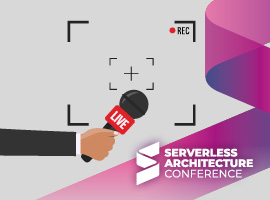Jul
31,
2019
“Expect serverless to become more mainstream”
Serverless is a hotly discussed topic right now, and it seems to mean different things to different people. We caught up with Lee Atchison, Senior Director, Cloud Architecture at New Relic to discuss what serverless means to him, how it’s changing the way applications are developed and what implications serverless...
Jun
3,
2019
GraphQL, Serverless and the Cloud-native State of the Art
Serverless is without a question a very hyped topic in the tech industry right now. At the Serverless Architecture Conference 2019 in The Hague we talked to Marcia Villalba, Full Stack Editor at Rovio, about the Status Quo of Serverless and why GraphQL fits so perfectly in this concept.
May
27,
2019
“Serverless is unlikely to completely remove the need for system administrators or operators”
Is serverless eating the world? Or at least some containers? Well, let’s start at the beginning. We talked to Erwin van Eyk, software engineer at Platform9, about what serverless really is and how it will and already does change the daily work-life of developers and operators. Our expert also gave...
May
6,
2019
Distributed Tracing: Modern Debugging in Times of Serverless
As Serverless is on the rise, the art of debugging and tracing is changing, too, as well as the day to day work life of developers and admins. At the Serverless Architecture Conference 2019 in The Hague we talked to Billie Thompson, cloud-native consultant at Armakuni, about how Serverless is...
/
Apr
30,
2019
Thoughts following the Serverless Architecture Conference
The recent Serverless Architecture Conference in The Hague, Netherlands brought together developers and DevOps engineers from across Europe. And if any topic was guaranteed to ignite a heated debate among participants it was Knative vs. Serverless.
Apr
8,
2019
Serverless workloads on Kubernetes with Knative
Serverless is a buzzword that everybody seems to be talking about nowadays. You may like the term or not, but the important thing here is what it describes. In a nutshell, Serverless means the application's scale is constantly adapted to ensure that you always have the exact amount of resources...
Jan
11,
2019
What exactly is Knative? an introduction with Evan Anderson from Google
What are the benefits of serverless computing? What exactly is Knative and what features are still in development? In our interview with Evan Anderson, Senior Staff Software Engineer at Google, he gives an introduction to the new shiny serverless tooling based on Kubernetes. He also talks about the benefits and...
Dec
11,
2018
Highly optimized APIs: Integrating GraphQL in serverless architecture
With three years on the market, GraphQL is a sophisticated and established alternative to REST. It should be taken into consideration when creating or further developing an API. Various applications such as Facebook, Instagram, and XING already successfully use this REST alternative. This is enough reason to give an insight...






